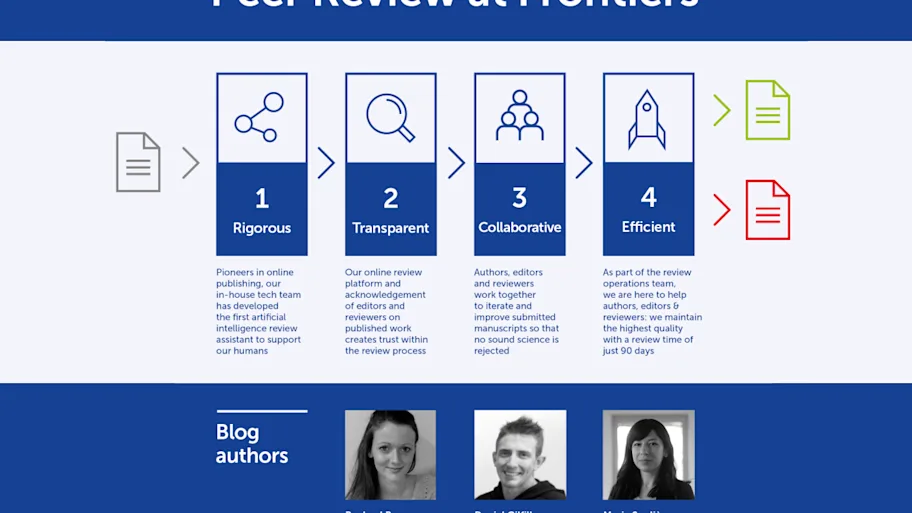
- Science news
- Frontiers news
- Rigorous, constructive, efficient and transparent – collaborative peer review
Rigorous, constructive, efficient and transparent – collaborative peer review
Author: Yasmin Dahesh, Review Operations Specialist
Yasmin joined Frontiers in September 2019, after completing her Masters in Cancer Research. As a Review Operations Specialist, Yasmin oversees the peer-review of manuscripts submitted to Frontiers in Oncology.

As a leading open access publisher, at Frontiers we focus on building on successful science and ensuring that science is openly available. With more than 100 community-run open-access journals led by top researchers and clinicians in the field, we are one of the largest and most-cited publishers in the world. By striving to ensure that each and every manuscript we publish has gone through an objective, rigorous and transparent peer-review process, we are able to maximize efficiency without compromising on quality.
“Make science open.” This mission is at the heart of Frontiers. To accomplish this, we have developed an in-house Open Science technology platform. This platform includes features such as: a Digital Editorial Office - a dashboard for our Chief Editors to streamline their activities; the myFrontiers centralized platform, which offers all users up to date information about their editorial contributions; and most excitingly, our Collaborative Peer Review platform. This unique platform has revolutionized peer-review, allowing for an open, fair and constructive collaboration between Editors, Reviewers and Authors.
There are several different types of peer review in scholarly publishing. Frontiers uses a single-blind peer-review process, where Authors do not know the identities of the Reviewers until their manuscript is published. The review process comprises two phases: the independent stage and the interactive, collaborative stage.
Phase 1: Independent Review
Takes place when one of our Editors, an expert in their field, makes an initial assessment of the manuscript and ensures its suitability for review. Invitations are then sent to Reviewers - also experts on the subject at hand. We provide a number of tools for the Reviewers to submit high quality review reports, including a questionnaire that prioritizes scientific quality, rigor and validity, ensuring that the research presented is supported by sufficient data. To once again ensure high quality reports, our questionnaires are tailored to specific article types, for example Original Research Articles vs Clinical Trial Articles.
Phase 2: Interactive Review
Following an assessment of the reports by the Editor, the Interactive Review is activated, giving the authors access to the Reviewers comments. In addition to this, Authors have the opportunity to interact with the Reviewers and Editor in real-time. Our platform also allows Reviewers to view all submitted reports, ensuring a thorough review. During this phase, a direct open dialogue is fostered among the Authors, Editor and Reviewers. Here, Authors have the ability to ask for further clarification from the Reviewers and to explain certain aspects of their research, providing point-by-point responses to the feedback submitted. This allows Editors and Reviewers to work together with the Authors to improve their manuscript.
Here’s an example of the types of interactions that take place on our platform:

The Reviewers can also recommend rejection at this stage, should their feedback to correct objective errors not be met by the Authors or if the overall quality of the paper is deemed insufficient. The Editor is notified of these recommendations and can make a further assessment on the manuscript. Should they want a further opinion, they can assign more Reviewers and should they agree, can bring the case to the attention of the Chief Editor.
Not only does our platform provide an efficient review process, guiding Authors, Reviewers and Editors smoothly through each stage of the process and alerting them when any action is required; it also allows for utmost transparency. While the identities of Reviewers remain anonymous during the review period, once accepted for publication, the names of the Reviewers who endorsed appear on the published article, without exceptions. If a Reviewer recommends rejection or withdraws during any stage of this process, their name will not be disclosed. The handling Editor’s name is also made public on the published article, acknowledging their contribution.
This ensures that Editors and Reviewers hold a level of accountability and responsibility for the papers they review and endorse.
Don’t just take our word for it. Feedback from our community shows that the vast majority of the research community holds our Collaborative Review platform in high esteem. For example, last year:
89% of Authors rated our Collaborative Review process as good or excellent
93% of Reviewers rated our Collaborative Review process as good or excellent
89% of Editors rated our Collaborative Review process as good or excellent
Please find a link to our Progress Report 2020 here with more information.
At Frontiers, one of our main objectives is to aid in the improvement of scientific knowledge. Through our Interactive, Collaborative peer-review model, we allow Editors and Reviewers to contribute to the quality of the manuscripts they review; rather than judge solely on impact or novelty, which can often be highly subjective. This ensures that papers will receive a high quality and efficient peer review.






